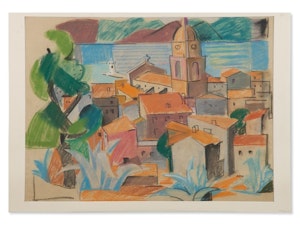"In 1932, Scales became one of only two antipodean students to train at Munich's Hans Hofmann School of Fine Art.121 That same year she had witnessed the Sturmabteilung, or Brownshirts, marching their way through the city.122 She stopped for a time in St Tropez, where from the citadel, she sketched the view over the bay in Basilica and Lighthouse, St Tropez, Southern France, 1939 (p 173), with Our Lady of the Assumption Church jutting up into the gulf. Features in the small-scale painting appear as compressed blocks of colour that softly fuse into each other and anticipate the almost complete erosion of pictorial structures in Scales' late work.
121 Gwen Knight spent six months at the Hofmann School from 3 October 1929 to 2 April 1930.
122 'Timeline', Flora Scales, https:// florascales.com/timeline/ (accessed February 2024)."







